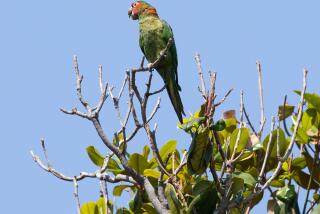Pigeons of St. Mark’s
- Share via
It is 1:25 in the afternoon in St. Mark’s Square in Venice and the pigeons, as usual, are fighting. They fight over every crumb from a tourist’s roll, and natter over every speck of corn.
They move in squabbles . . . sooty squabbles of pigeons bickering back and forth across this grand piazza, fighting to plant their bright pink feet where other pigeons have just planted theirs.
There are thousands of these petulant birds, but that’s no excuse for crowding. The square is almost 900 feet long. They could spread out and leave walkways.
Because I do not get on well with pigeons, I find it reassuring that they do not get on well with each other. They are a fractious lot, brooding over these stones like the powerful doges of yesteryear, always glancing over their shoulders, never trusting anyone completely.
2 O’Clock: All Change
It is 2 o’clock in St. Mark’s Square and the ornate blue-and-gilt bell tower cracks the hour. The pigeons go wild, puffing up from the pavement like storm clouds. From rooftops and domes, from conical chimneys and the statues of saints, other hordes blow down, a dingy cape dropped on the piazza.
A small boy gets loose from his mother’s grip and heads for the pigeons. There is sweet murder in his eyes. He puts a finger to his lips to silence his family, and then makes a running stomp. The birds get away in a flurry, of course, but a few feathers fall behind. He scoops them up as trophies of the hunt and sticks them into his pocket.
Tourists give him a cheer and snap his picture. I take refuge in the covered arcade that flanks the square, where I am in the company of cringing cats who can only lurk and dream.
The pigeons know they are safe. With a confidence bordering on arrogance, they mimic the sense of divine right borne by cows in Hindu lands. Pigeons are not worshiped in Venice, but they are respected. Since the Middle Ages, St. Mark’s has been their sanctuary. For years the city provided daily grain; now private industry foots the bill.
The Early Bird
It is 6:45 in the morning. I am drawn to St. Mark’s at dawn. It is early quiet. The birds are not yet about. The sun is orange. The air is clear. Four men in blue coveralls are sweeping the stones, using long-handled straw brooms.
Two navy officers appear far down the piazza, bobbing in their forward march like figures in a mirage. A nun in a knee-length habit scurries past the Basilica.
From the shadows of the Doges’ Palace I hear a cry: “Gamitbe,” which means “legs”--the warning of cart pushers who transport goods through these narrow streets. The cart holds suitcases covered with tags and stickers. It heaves toward the Grand Canal. A white-haired couple rushes behind, carrying cameras and trench coats and roses.
Alone once more, I plot my course. I take the center of St. Mark’s Square without a skirmish. I swirl in victory. For several precious moments the place is mine.
But I cannot hold it long. The pigeons will be fed at 9.
So I retreat, happy that I touched the ancient stones--and that my feet are not the color of bubble gum.
More to Read
Sign up for Essential California
The most important California stories and recommendations in your inbox every morning.
You may occasionally receive promotional content from the Los Angeles Times.












